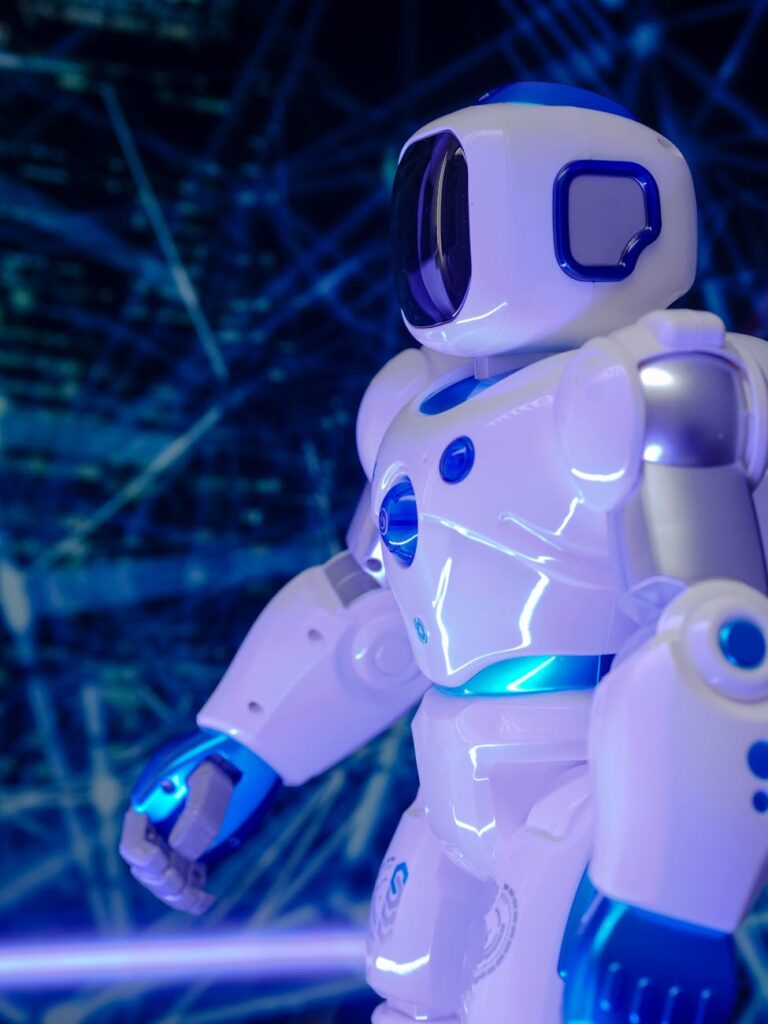2025 Tech Trends and AI Automation for Business Growth
Navigating the Future: Key 2025 Tech Trends and the Power of AI Automation for Businesses
Estimated reading time: 13 minutes
Key Takeaways
-
AI automation is crucial for efficiency, personalization, and cost reduction across content creation, repetitive tasks, and customer service, becoming a necessity for business survival and growth.
-
Web development trends in 2025 prioritize speed (Next.js), flexibility (Headless CMS), and user experience (responsive, accessible UI/UX) to create lightning-fast and intuitively designed digital front doors.
-
Cross-platform mobile app development (Flutter, React Native) offers faster time-to-market and cost efficiency for engaging user experiences, meeting the mobile-first paradigm.
-
Cloud computing and DevOps (serverless, CI/CD, cloud migration) are foundational for scalability, agility, and cost-efficient digital transformation, supporting your digital initiatives.
-
Successful digital transformation involves a holistic approach, integrating AI, cloud, and modern development practices to optimize workflows, enhance efficiency, and foster continuous innovation.
Table of Contents
- Embracing 2025 Tech Trends: The Dawn of a New Digital Era
- The AI Nexus: Intelligent Automation and Beyond
- Crafting the Digital Front Door: Web Development and UX Excellence
- Mobility Unleashed: Innovating with Cross-Platform Apps
- The Foundation of Agility: Cloud, DevOps, and Scalable Infrastructure
- Digital Transformation on a Budget for Small Companies
- How to Move Your Legacy App to the Cloud Without Breaking It
- Serverless Architecture: Create a Cost-Efficient Backend That Scales Automatically
- CI/CD for Small Teams: Automated Deployments Without the Headache
- Microservices Architecture
- Practical Takeaway for Businesses
- How AI TechScope Helps
- Synthesizing Success: Digital Transformation and Workflow Optimization
- Conclusion: Seizing the Future with AI TechScope
The digital landscape is a relentless current, constantly shifting and accelerating. For business professionals, entrepreneurs, and tech-forward leaders, understanding and leveraging these shifts isn’t just an advantage—it’s a necessity for survival and growth. As we gaze towards 2025, a confluence of groundbreaking 2025 tech trends is poised to redefine how businesses operate, innovate, and connect with their customers. From the pervasive influence of artificial intelligence to the foundational shifts in web and mobile development, cloud infrastructure, and user experience, this era promises unprecedented opportunities. At the heart of this transformation lies AI automation for businesses, a powerful force enabling companies to achieve unparalleled efficiency and unlock new avenues for value creation.
This comprehensive guide will break down the most significant developments across critical technology domains, offering insights into their practical applications and demonstrating how embracing these innovations can drive substantial competitive advantage. We’ll explore how these trends interconnect, shaping a future where agility, intelligence, and seamless user experiences are paramount.
Embracing 2025 Tech Trends: The Dawn of a New Digital Era
The pace of technological evolution shows no signs of slowing. Instead, it’s converging, creating a synergistic effect where advancements in one area amplify possibilities in others. For businesses looking to thrive in the coming years, a strategic understanding of these developments is crucial. This means not just observing, but actively planning for integration, from optimizing your digital presence to streamlining your internal operations.
The AI Nexus: Intelligent Automation and Beyond
Artificial Intelligence continues its inexorable march, moving beyond experimental phases into practical, business-critical applications. The true power of AI in 2025 isn’t just in its ability to generate text or images, but in its capacity to automate complex workflows, personalize user experiences, and unlock unprecedented operational efficiencies.
Revolutionizing Content Creation and Beyond
Consider the recent advancements by companies like ElevenLabs, which are now enabling authors to create and publish AI-generated audiobooks on their platforms. This isn’t merely a novelty; it signals a profound shift in content creation, making high-quality, personalized content accessible to a broader audience at a fraction of traditional costs. For businesses, this translates into opportunities for personalized marketing content, automated voiceovers for training materials, and scalable content localization. Imagine the impact of dynamically generated, localized audio product descriptions or AI-narrated whitepapers tailored to individual listener preferences.
Low-Effort AI Features That Delight Users
For SaaS providers and product developers, integrating AI doesn’t always require massive overhauls. Often, the most impactful AI features are those that subtly enhance user experience without demanding significant development effort. Think of intelligent search capabilities that understand user intent, automated summarization of long documents within an application, or predictive analytics that suggest next steps based on user behavior. These “smart” features delight users by reducing friction, saving time, and making products feel more intuitive and powerful. By identifying common user pain points or repetitive actions, businesses can pinpoint opportunities for simple, yet effective, AI enhancements.
Automating Repetitive Tasks with No-Code Tools + AI
One of the most immediate and impactful applications of AI for businesses is in automating repetitive, time-consuming tasks. The rise of no-code automation platforms, coupled with sophisticated AI models, empowers even small teams to create powerful workflows that save hours each week. From automatically categorizing customer support tickets using natural language processing (NLP) to extracting specific data points from invoices and entering them into a CRM, the possibilities are vast. This frees up valuable human capital to focus on strategic initiatives, creative problem-solving, and tasks that truly require human intelligence and empathy.
Chatbot Automation for Small Businesses
For small businesses operating on tight budgets and limited staff, AI chatbots are no longer a luxury but a strategic necessity. Modern chatbots, powered by advanced conversational AI, can handle a wide range of customer inquiries, provide instant support, qualify leads, and even complete simple transactions. Real-world workflows demonstrate how chatbots can answer frequently asked questions, guide users through product setup, schedule appointments, or collect basic customer information 24/7. This not only enhances customer satisfaction through immediate responses but also significantly reduces the workload on human staff, allowing them to focus on complex issues.
Practical Takeaway for Businesses
-
Start by identifying manual, repetitive tasks across your organization – from marketing and sales to customer service and back-office operations.
-
Explore low-effort AI integrations for your existing products to enhance user experience.
-
Investigate no-code AI automation platforms (like those compatible with n8n) to streamline workflows and free up your team for higher-value activities.
How AI TechScope Helps
At AI TechScope, our expertise in AI automation for businesses is central to our mission. We specialize in developing intelligent automation solutions using tools like n8n, integrating AI models to optimize workflows, and providing virtual assistant services that leverage these cutting-edge capabilities. Whether it’s building custom chatbots for customer service, automating data entry, or streamlining complex business processes, we help businesses harness the power of AI to scale operations, reduce costs, and improve efficiency through intelligent delegation and automation solutions.
Crafting the Digital Front Door: Web Development and UX Excellence
Your website is often the first impression a potential customer has of your business. In 2025, the demand for lightning-fast, highly responsive, and intuitively designed web experiences will be non-negotiable. Web development trends are heavily focused on performance, modularity, and user-centric design.
The Speed Imperative: Next.js and React Performance
Page load speed is a critical factor in user retention, conversion rates, and SEO rankings. Modern frameworks like Next.js have emerged as powerhouses for building fast, scalable web applications. Next.js, with its server-side rendering (SSR) and static site generation (SSG) capabilities, allows small businesses to build a fast marketing site in one weekend, providing an immediate performance advantage. For existing React applications, even simple React performance fixes, such as lazy loading components, optimizing image delivery, and memoizing functional components, can reduce page load times by seconds—a significant improvement that can boost engagement by 60% or more, as demonstrated in real-world case studies.
Headless CMS: WordPress Without the Bloat
Traditional monolithic content management systems (CMS) can often be slow and inflexible. The shift towards a headless CMS architecture, especially with platforms like WordPress, allows businesses to use WordPress purely for content management while delivering that content to any frontend framework (like Next.js or React) via APIs. This decoupling offers unparalleled flexibility, better performance, and enhanced security. By utilizing lightweight plugins that actually help SEO and avoiding bloat, businesses can maintain the familiarity of WordPress for content creators while providing a modern, fast user experience.
Micro Frontends: When They Help and When They Hurt
As web applications grow in complexity, managing large, monolithic frontends becomes challenging. Micro frontends offer a solution by breaking down the user interface into smaller, independently deployable units. This approach fosters team autonomy, allows for technology stack diversity, and simplifies continuous integration. However, micro frontends introduce overhead in terms of setup, communication, and consistent styling. They help most when dealing with large, diverse teams working on complex applications with distinct feature sets, but can add unnecessary complexity for smaller, simpler projects. Understanding these practical examples is key to deciding if this architectural pattern is right for your business.
Modern UI/UX Design: Accessibility and Responsiveness
Beyond speed, user experience (UX) is paramount. Modern UI/UX design emphasizes intuitive navigation, aesthetic appeal, and, crucially, accessibility. Designing accessible buttons, for example, is not just about compliance but about ensuring your digital presence serves all users, regardless of ability. Simple Figma tips or design system guidelines can help non-designers implement inclusive practices. Responsive UI design is no longer an option; it’s a fundamental expectation. Websites and applications must seamlessly adapt to various screen sizes and devices, providing a consistent and optimal experience whether viewed on a desktop, tablet, or smartphone.
Practical Takeaway for Businesses
-
Prioritize website and application performance; consider upgrading to modern frameworks like Next.js.
-
Explore headless CMS solutions for content flexibility and speed.
-
Invest in good UI/UX design, focusing on responsiveness and accessibility.
-
Conduct regular performance audits.
How AI TechScope Helps
AI TechScope excels in web development trends, specializing in building high-performance websites and web applications using Next.js and React. Our expertise extends to performance optimization techniques, ensuring your digital presence is not only visually appealing but also lightning-fast. We guide clients through headless CMS implementations and apply modern UI/UX design principles to create intuitive, accessible, and engaging user experiences that drive conversions and foster loyalty.
Mobility Unleashed: Innovating with Cross-Platform Apps
The mobile-first paradigm continues to dominate, with users increasingly relying on their smartphones for everything from communication and entertainment to banking and shopping. Mobile app development 2025 is characterized by the ongoing debate between native and cross-platform solutions, with frameworks like Flutter and React Native leading the charge.
Flutter vs. React Native in 2025
The choice between Flutter vs. React Native remains a critical decision for businesses embarking on mobile app development. Both frameworks allow developers to build cross-platform apps from a single codebase, significantly reducing development time and cost compared to building separate native apps for iOS and Android. In 2025, Flutter continues to impress with its performance, beautiful UI capabilities, and rapid development cycles, making it an excellent choice for startups needing to quickly bring a visually rich app to market. React Native, backed by Facebook, benefits from a vast ecosystem and strong community support, making it ideal for teams with existing JavaScript expertise or those needing deep native module integration. The best choice for your business app depends on your specific needs, team skillset, and long-term vision.
Building Simple Cross-Platform Apps
The barrier to entry for mobile app development has significantly lowered. With frameworks like Flutter, building a simple cross-platform app from idea to Play Store is more accessible than ever. This empowers businesses, even with limited development resources, to create internal tools, customer-facing applications, or proof-of-concept prototypes rapidly. These frameworks provide a rich set of pre-built widgets and tools, streamlining the development process and allowing for quick iteration.
Mobile App UI Trends
Current mobile app UI trends lean towards minimalist designs, gesture-driven interfaces, dark mode options, and hyper-personalization. Rich animations, fluid transitions, and micro-interactions enhance user delight and provide a premium feel. The focus is on creating immersive experiences that are both visually appealing and highly functional, adapting to individual user preferences and behaviors.
Practical Takeaway for Businesses
-
Assess your mobile app strategy.
-
Consider cross-platform development for faster time-to-market and cost efficiency.
-
Research Flutter vs. React Native thoroughly based on your specific project requirements and team’s expertise.
-
Prioritize modern, intuitive, and personalized mobile UI.
How AI TechScope Helps
AI TechScope provides expert consulting on mobile app development 2025 strategies, helping businesses navigate the complexities of framework selection (Flutter vs. React Native) and build robust, high-performing mobile applications. We guide you through the entire development lifecycle, ensuring your app not only meets user expectations but also aligns with your business objectives and mobile app UI trends.
The Foundation of Agility: Cloud, DevOps, and Scalable Infrastructure
The underlying infrastructure that supports your digital initiatives is as critical as the applications themselves. Cloud computing and DevOps practices are no longer cutting-edge but foundational to achieving operational agility, scalability, and resilience.
Digital Transformation on a Budget for Small Companies
Many small companies believe digital transformation is only for large enterprises. However, digital transformation strategies can be implemented on a budget. Seven steps small companies can start today include migrating core services to the cloud, adopting SaaS tools for key functions, automating repetitive tasks, leveraging data analytics, enhancing cybersecurity, improving digital customer engagement, and fostering a culture of innovation. These steps often involve utilizing cloud-native services and adopting DevOps principles to streamline operations without massive upfront investments.
How to Move Your Legacy App to the Cloud Without Breaking It
Migrating legacy applications to the cloud can seem daunting, fraught with risks of downtime and data loss. However, with careful planning and a phased approach, it’s achievable. Strategies include re-hosting (lift-and-shift), re-platforming (minimal changes for cloud benefits), re-factoring (re-architecting for cloud-native), and replacing with SaaS solutions. Cloud migration strategy involves thorough assessment, pilot projects, data migration planning, and robust testing to ensure a smooth transition and unlock the scalability and cost-efficiency benefits of the cloud.
Serverless Architecture: Create a Cost-Efficient Backend That Scales Automatically
Serverless architecture, particularly on platforms like AWS Lambda, represents a paradigm shift in backend development. It allows developers to build and run applications and services without managing servers. This “pay-per-execution” model significantly reduces operational costs, especially for applications with fluctuating traffic. For startups or projects needing a cost-efficient backend that scales automatically with demand, serverless is an ideal solution. It eliminates the need for server provisioning, patching, and scaling, letting developers focus purely on code. An example of serverless AWS cost shows how a backend handling millions of requests can incur surprisingly low infrastructure costs.
CI/CD for Small Teams: Automated Deployments Without the Headache
DevOps best practices are essential for accelerating software delivery and improving reliability. For small teams, implementing Continuous Integration/Continuous Delivery (CI/CD) automation doesn’t have to be a headache. Tools like GitHub Actions provide simple, yet powerful, ways to automate deployments. A CI/CD small team can set up automated tests, builds, and deployments with a tutorial that guides them through creating workflows to push code directly to production environments after successful tests. This significantly reduces manual errors, speeds up release cycles, and ensures consistent quality.
Microservices Architecture
While we touched upon Micro Frontends, the concept of microservices architecture extends to the backend. Instead of a single, monolithic application, microservices break down an application into small, independent services that communicate with each other through APIs. Each service can be developed, deployed, and scaled independently, offering greater flexibility, resilience, and agility. This architecture is particularly beneficial for complex enterprise applications that require continuous updates and diverse technology stacks.
Practical Takeaway for Businesses
-
Embrace cloud-native principles, starting with a clear cloud migration strategy for legacy systems.
-
Invest in DevOps best practices and CI/CD automation to streamline development and deployment.
-
Explore serverless architectures for new projects or specific functionalities to optimize costs and scalability.
How AI TechScope Helps
AI TechScope is a leader in cloud computing and DevOps, providing comprehensive services from cloud migration strategy and implementation to setting up robust CI/CD automation pipelines. We help businesses design and implement scalable serverless architecture solutions, optimize their infrastructure for performance and cost efficiency, and adopt DevOps best practices to foster an agile and resilient development environment.
Synthesizing Success: Digital Transformation and Workflow Optimization
Ultimately, all these 2025 tech trends converge on a single objective: enabling profound digital transformation strategies that optimize workflows, enhance efficiency, and unlock new growth opportunities. It’s about building a connected, intelligent, and responsive enterprise.
Workflow Automation Tools and Enterprise Digital Adoption
The synergy between AI, cloud, and modern development practices empowers businesses to build truly integrated and automated ecosystems. Workflow automation tools, often powered by AI, bridge the gaps between disparate systems, automating data transfer, decision-making, and communication. This leads to seamless enterprise digital adoption, where new technologies are not just implemented but deeply integrated into the fabric of daily operations, transforming how work gets done. From automated lead nurturing sequences in marketing to intelligent inventory management systems, the potential for optimization is endless.
SaaS Product Optimization and Digital Innovation for Startups
For SaaS businesses, leveraging these trends means constant SaaS product optimization—embedding AI features, ensuring blazing-fast performance, and providing a superior user experience. For startups, these technologies represent digital innovation for startups, offering the tools to build lean, scalable, high-performance products and services from day one. Choosing the right tech stack for modern businesses, from Next.js for the frontend to serverless for the backend and AI for intelligent features, is crucial for rapid growth and market penetration.
Practical Takeaway for Businesses
-
Adopt a holistic view of technology.
-
Connect your web, mobile, and backend strategies.
-
Continuously seek opportunities for workflow automation and AI integration across all departments.
-
Foster a culture of digital adoption and continuous improvement.
How AI TechScope Helps
As your trusted partner in digital innovation for startups and established enterprises, AI TechScope provides comprehensive AI consulting services. We specialize in identifying opportunities for workflow automation tools, implementing intelligent delegation solutions, and guiding businesses through their entire digital transformation strategies. Our expertise spans n8n automation, custom AI solutions, and full-stack development, ensuring your business is equipped with a robust tech stack for modern businesses that is agile, intelligent, and scalable.
Conclusion: Seizing the Future with AI TechScope
The 2025 tech trends we’ve explored—from advanced AI automation for businesses and high-performance web development with Next.js, to agile mobile app creation with Flutter and React Native, and robust cloud/DevOps infrastructure—are not merely buzzwords. They are the building blocks of competitive advantage in the coming years. Embracing these innovations means higher efficiency, reduced costs, enhanced customer experiences, and the agility to adapt to an ever-changing market.
Navigating this complex landscape requires strategic insight, technical expertise, and a partner committed to your success. AI TechScope is uniquely positioned to empower your business to not only understand these trends but to actively implement them. Our specialization in AI-powered automation, n8n workflow development, AI consulting, and cutting-edge website development makes us the ideal ally for your digital journey. We help you move beyond manual processes, unlock the power of intelligent delegation, and build a resilient, future-ready enterprise.
Don’t let the future pass you by. It’s time to transform your business with intelligent automation and cutting-edge technology.
Ready to Accelerate Your Digital Transformation?
Is your business prepared to leverage the power of AI automation, next-generation web technologies, and agile cloud solutions?
Contact AI TechScope today to explore our AI automation and consulting services. Let us help you identify opportunities, optimize your workflows, and build the intelligent, efficient, and scalable business you envision for 2025 and beyond.
Explore AI TechScope’s Services Now!
Frequently Asked Questions (FAQ)
What are the key tech trends for businesses in 2025?
The key tech trends for businesses in 2025 include advanced AI automation, high-performance web development with frameworks like Next.js, agile cross-platform mobile app development using Flutter and React Native, and robust cloud computing and DevOps practices for scalable infrastructure.
How can AI automation benefit my small business?
AI automation can significantly benefit small businesses by revolutionizing content creation, enhancing user experience with low-effort AI features, automating repetitive tasks using no-code tools, and providing 24/7 customer support through advanced chatbots. This leads to increased efficiency, reduced costs, and allows human capital to focus on strategic tasks.
Why is website performance so important for businesses in 2025?
Website performance is critical in 2025 because page load speed directly impacts user retention, conversion rates, and SEO rankings. Modern UI/UX design also emphasizes intuitive navigation, responsiveness across devices, and accessibility. Slow or poorly designed websites lead to higher bounce rates and missed opportunities.
Should my business choose Flutter or React Native for mobile app development?
Both Flutter and React Native are excellent cross-platform frameworks. Flutter offers high performance and beautiful UI, ideal for visually rich apps and rapid development. React Native boasts a vast ecosystem and is great for teams with existing JavaScript expertise or those needing deep native integrations. The best choice depends on your specific project requirements, team skillset, and long-term vision.
How can AI TechScope help my business implement these 2025 tech trends?
AI TechScope specializes in providing comprehensive AI consulting, intelligent automation solutions (including n8n workflow development), cutting-edge website development using Next.js and React, and mobile app development strategies. We help businesses identify opportunities, optimize workflows, implement robust cloud and DevOps infrastructures, and guide their digital transformation to build agile, intelligent, and scalable enterprises.







